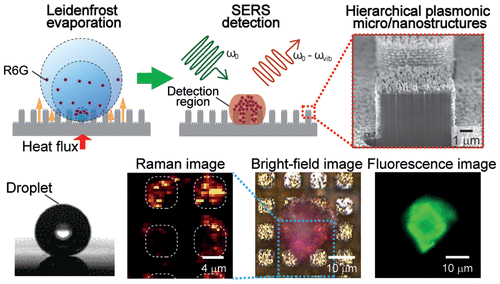Our official English website, www.x-mol.net, welcomes your feedback! (Note: you will need to create a separate account there.)
Partial Leidenfrost Evaporation-Assisted Ultrasensitive Surface-Enhanced Raman Spectroscopy in a Janus Water Droplet on Hierarchical Plasmonic Micro-/Nanostructures.
ACS Nano ( IF 17.1 ) Pub Date : 2020-06-26 , DOI: 10.1021/acsnano.0c04239 Junyeob Song 1 , Weifeng Cheng 2 , Meitong Nie 1 , Xukun He 2 , Wonil Nam 1 , Jiangtao Cheng 2 , Wei Zhou 1
ACS Nano ( IF 17.1 ) Pub Date : 2020-06-26 , DOI: 10.1021/acsnano.0c04239 Junyeob Song 1 , Weifeng Cheng 2 , Meitong Nie 1 , Xukun He 2 , Wonil Nam 1 , Jiangtao Cheng 2 , Wei Zhou 1
Affiliation

|
The conventional methods of creating superhydrophobic surface-enhanced Raman spectroscopy (SERS) devices are by conformally coating a nanolayer of hydrophobic materials on micro-/nanostructured plasmonic substrates. However, the hydrophobic coating may partially block hot spots and therefore compromise Raman signals of analytes. In this paper, we report a partial Leidenfrost evaporation-assisted approach for ultrasensitive SERS detection of low-concentration analytes in water droplets on hierarchical plasmonic micro-/nanostructures, which are fabricated by integrating nanolaminated metal nanoantennas on carbon nanotube (CNT)-decorated Si micropillar arrays. In comparison with natural evaporation, partial Leidenfrost-assisted evaporation on the hierarchical surfaces can provide a levitating force to maintain the water-based analyte droplet in the Cassie–Wenzel hybrid state, i.e., a Janus droplet. By overcoming the diffusion limit in SERS measurements, the continuous shrinking circumferential rim of the droplet, which is in the Cassie state, toward the pinned central region of the droplet, which is in the Wenzel state, results in a fast concentration of dilute analyte molecules on a significantly reduced footprint within several minutes. Here, we demonstrate that a partial Leidenfrost droplet on the hierarchical plasmonic surfaces can reduce the final deposition footprint of analytes by 3–4 orders of magnitude and enable SERS detection of nanomolar analytes (10–9 M) in an aqueous solution. In particular, this type of hierarchical plasmonic surface has densely packed plasmonic hot spots with SERS enhancement factors (EFs) exceeding 107. Partial Leidenfrost evaporation-assisted SERS sensing on hierarchical plasmonic micro-/nanostructures provides a fast and ultrasensitive biochemical detection strategy without the need for additional surface modifications and chemical treatments.
中文翻译:

分层等离子微/纳米结构上Janus水滴中的部分Leidenfrost蒸发辅助超灵敏表面增强拉曼光谱。
产生超疏水表面增强拉曼光谱(SERS)装置的常规方法是在微/纳米结构的等离激元基板上共形涂覆疏水材料的纳米层。但是,疏水涂层可能会部分阻塞热点,因此会损害分析物的拉曼信号。在本文中,我们报告了部分莱顿弗罗斯特蒸发辅助方法,用于通过在碳纳米管(CNT)修饰的Si上集成纳米层压金属纳米天线而制造的分层等离激元微/纳米结构上的超灵敏SERS检测水滴中低浓度分析物微柱阵列。与自然蒸发相比,即Janus小滴。通过克服SERS测量中的扩散极限,处于Cassie状态的液滴向着处于Wenzel状态的液滴的固定中心区域连续收缩的圆周边缘导致稀释的分析物分子快速浓缩在几分钟内大大减少了占地面积。在这里,我们证明了分层等离激元表面上的部分莱顿弗罗德小滴可以将分析物的最终沉积足迹减少3-4个数量级,并使SERS检测水溶液中的纳摩尔分析物(10–9 M)成为可能。特别是,这种类型的分层等离子表面具有密集堆积的等离子热点,其SERS增强因子(EFs)超过10 7。分层等离激元微观/纳米结构上的部分Leidenfrost蒸发辅助SERS感测提供了快速,超灵敏的生化检测策略,无需进行其他表面修饰和化学处理。
更新日期:2020-08-25
中文翻译:

分层等离子微/纳米结构上Janus水滴中的部分Leidenfrost蒸发辅助超灵敏表面增强拉曼光谱。
产生超疏水表面增强拉曼光谱(SERS)装置的常规方法是在微/纳米结构的等离激元基板上共形涂覆疏水材料的纳米层。但是,疏水涂层可能会部分阻塞热点,因此会损害分析物的拉曼信号。在本文中,我们报告了部分莱顿弗罗斯特蒸发辅助方法,用于通过在碳纳米管(CNT)修饰的Si上集成纳米层压金属纳米天线而制造的分层等离激元微/纳米结构上的超灵敏SERS检测水滴中低浓度分析物微柱阵列。与自然蒸发相比,即Janus小滴。通过克服SERS测量中的扩散极限,处于Cassie状态的液滴向着处于Wenzel状态的液滴的固定中心区域连续收缩的圆周边缘导致稀释的分析物分子快速浓缩在几分钟内大大减少了占地面积。在这里,我们证明了分层等离激元表面上的部分莱顿弗罗德小滴可以将分析物的最终沉积足迹减少3-4个数量级,并使SERS检测水溶液中的纳摩尔分析物(10–9 M)成为可能。特别是,这种类型的分层等离子表面具有密集堆积的等离子热点,其SERS增强因子(EFs)超过10 7。分层等离激元微观/纳米结构上的部分Leidenfrost蒸发辅助SERS感测提供了快速,超灵敏的生化检测策略,无需进行其他表面修饰和化学处理。



























 京公网安备 11010802027423号
京公网安备 11010802027423号